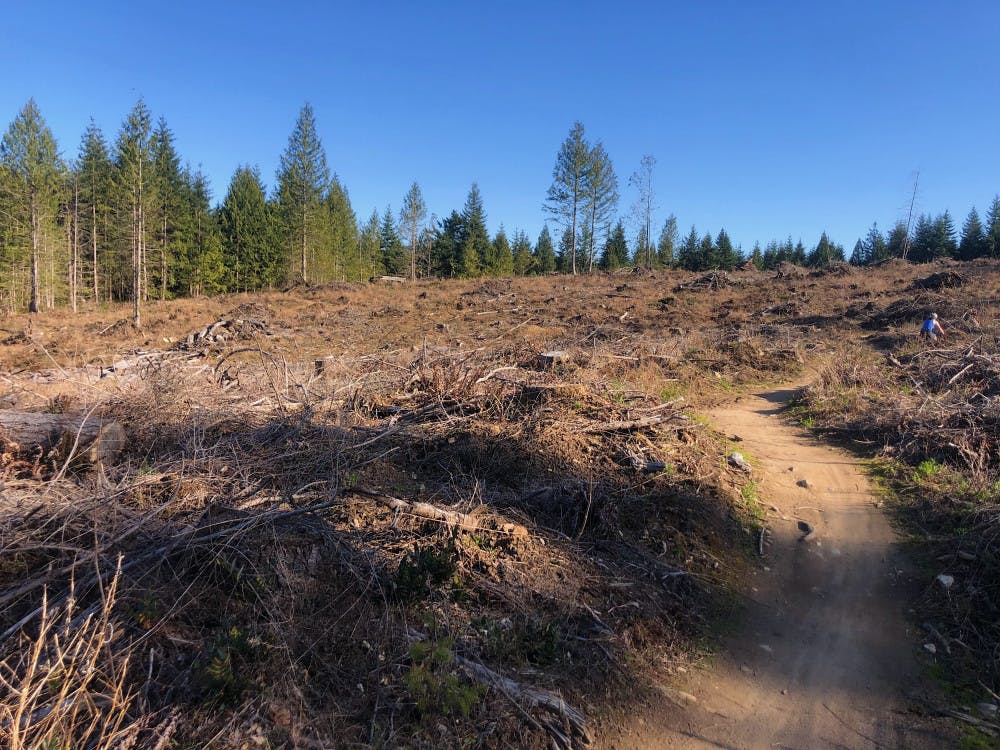Whatcom Mountain Bike Coalition elaborates on management and further operations

Galbraith Mountain is one of the most well-renowned mountain biking locations in the state of Washington. With over 65 miles of public trails and a wide degree of trail difficulty it attracts mountain bikers in large numbers. But one possible hindrance to this two-wheeled playground is that Galbraith Mountain, like many mountain biking destinations in Western Washington, is subject to logging.
The land Galbraith Mountain sits on is owned by the Polygon Corporation, which contracts through Janicki Logging allowing Galbraith Tree Farm to harvest timber on the mountain. Whatcom Mountain Bike Coalition, a non-profit organization which works to maintain trail access in Whatcom County, holds a recreational use agreement that permits the building and maintenance of trails on Galbraith Mountain.
Eric Brown, executive director of WMBC, manages all logistical operations with land owners on Galbraith Mountain.
“We meet with Galbraith Tree Farm / Janicki Logging annually to discuss their timber harvest plans along with our upcoming trail projects,” Brown said in an email. “However, we are very nimble as plans can change depending on logging schedules, weather, timber prices, diseased trees, etc.”
This communication is critical with the large volume of mountain bikers present on the mountain, and the management between logging and rider traffic is crucial for safety and efficiency.
As of 2019, Galbraith Mountain was named the most popular mountain bike trail center in Washington state by Singletracks.com. This title attracts even more riders to the area. WMBC’s strategy for keeping all these riders safe is to close down trails which overlap with active logging areas.
“When timber activities are taking place, our goal is to minimize trail closures,” Brown said. “As such, we are usually speaking with Janicki Logging crews every day or two which allows us to make real-time decisions on closing trails as they move across the mountain.”
But in such a forested environment, pine trees are needed for maintaining soil composition and preventing erosion by absorbing groundwater and stabilizing soil. Brown commented on how logging changes the mountain, often for the better.
“It’s allowed us to change the network where necessary or add new trails when it’s an option,” Brown said.
In order for an area of Galbraith to be logged, any trails must be closed until it is safe to reopen. In such a high-trafficked area, logging and the reduction of available trails could be seen as a nuisance for many mountain bikers. Brown said that this wasn’t usually the case.
“We rarely get complaints about logging,” Brown said. “Most trail users who have been using the mountain for any length of time, have seen the mountain transform over the years as areas are harvested, trails are rebuilt and areas are replanted and grown back.”
This sentiment seems to be true for regular trail users. Hudson Soelter is a resident of Bellingham and a regular Galbraith trail user.
“Obviously, it’s less than ideal to have trails closed,” Soelter, who was heading up for a day of biking, said. “But, on the other hand, it’s really awesome to have these public, sanctioned trails to enjoy, so if that’s the price we have to pay to use them, so be it, I’m all for it.”
“[Logging is] okay, trees are one of the only renewable resources we have. So, if the logging company logs sustainably, it’s good, I welcome them to utilize the land and the trails,” said Sylas Linnemann, another avid trail user and Bellingham resident.
Since the COVID-19 pandemic, more people have been exercising outside to practice social distance. This has increased the traffic on Galbraith with more people beginning to take up mountain biking as a hobby, Brown said.
“In many ways, it's a great problem to have,” Brown said. “But we've been dealing with stuff like neighborhood complaints, parking issues, some basic etiquette knowledge, etc.”
One of the biggest problems in regards to the COVID-19 pandemic has been overcrowded parking lots causing many cars to park on the shoulders of busy roads.
“We're tackling the parking issue this fall by building a 140 stall parking lot off of Samish Way,” Brown said. “If folks want to donate to that effort, they can do so by going to [the fundraising site].”
But Brown maintained his appreciation for the outdoor community in Whatcom County, despite the recent challenges.
“The best part of managing Galbraith is our incredible community that takes a ton of pride and ownership over the mountain,” Brown said. “I'm super proud that our Trail Adopters, trail builders (mostly volunteers) and small staff do a great job of keeping the network running at a high level considering the sheer volume of use along with the timber activity there has been in recent years.”
As for future efforts, “Galbraith is a dynamic trail system, so keeping the general public aware of changes, closures and new projects is an ongoing process,” Brown said.
Logging on Galbraith Mountain has become an integral part of how the trail systems function, and the regulars at Galbraith seems to know this.
Talus Lantz is a sports reporter for The Front and a second-year environmental journalism major at Western. His work focuses on recreational sports and local environmental issues. He enjoys mountain biking and skiing in his free time. You can reach him at taluslantz.thefront@gmail.com.




